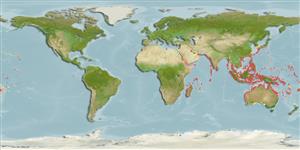Environment: milieu / climate zone / depth range / distribution range
Ekologi
laut; payau berasosiasi dengan karang; nir-ruaya; kisaran kedalaman 0 - 6 m (Ref. 86942). Subtropical; 35°N - 36°S, 18°E - 159°W
Indo-West Pacific: Red Sea and East Africa to Samoa, north to the Ryukyu Islands, south to northern Australia and New Caledonia. Migrated to the eastern part of the Mediterranean Sea via the Suez Canal.
Length at first maturity / Size / Weight / umur
Maturity: Lm 23.1, range 18 - ? cm
Max length : 45.0 cm TL jantan/; (Ref. 30573); common length : 30.0 cm TL jantan/; (Ref. 5450); Umur maksimum dilaporkan: 4 Tahun (Ref. 126539)
Duri punggung (Keseluruhan (total)) : 0; duri punggung lunak (Keseluruhan (total)) : 12 - 15; Duri dubur: 0; Sirip dubur lunak: 10 - 12. Greatly prolonged, beak-like lower jaw; upper jaw short, triangular and without scales; preorbital ridge absent; total number of gill rakers on first gill arch 25-36; pectoral fins short, not reaching past nasal pit when folded forward; with 3-9 (usually 4-6) vertical bars on the sides. (Ref. 9843). Color bluish dorsally, silvery on sides. 36-41 predorsal scales. Lower lobe of caudal fin longer than upper lobe. Dorsal and anal fins located posteriorly.
Occur in coastal waters of high islands and continental shorelines; generally in areas rich in vegetation (Ref. 5213) and sand flats (Ref. 48635). Form schools. Adults feed mainly on seagrasses, to a lesser extent on green algae and diatoms (Ref. 9843). Breed in estuaries (Ref. 4164). Marketed fresh and dried salted (Ref. 5284, 9843); meat tasty (Ref. 637). Also caught with dragnets (Ref. 30573) and dipnets.
Life cycle and mating behavior
Maturities | Reproduksi, perkembang biakan | Spawnings | Egg(s) | Fecundities | Larva
Collette, B.B. and J. Su, 1986. The halfbeaks (Pisces, Beloniformes, Hemiramphidae) of the Far East. Proc. Acad. Nat. Sci. Philadelphia 138(1):250-301. (Ref. 10943)
Status IUCN Red List (Ref. 130435)
ancaman kepada manusia
Harmless
penggunaan manusia
Perikanan: komersial; Ikan buruan: ya; umpan: occasionally
Alat, peralatan
laporan khas
muat turun XML
Sumber internet
Estimates based on models
Preferred temperature (Ref.
123201): 24.7 - 29.3, mean 28.5 °C (based on 3383 cells).
Phylogenetic diversity index (Ref.
82804): PD
50 = 0.5005 [Uniqueness, from 0.5 = low to 2.0 = high].
Bayesian length-weight: a=0.00380 (0.00291 - 0.00496), b=3.07 (3.01 - 3.13), in cm total length, based on LWR estimates for this species (Ref.
93245).
Trophic level (Ref.
69278): 2.7 ±0.30 se; based on food items.
Daya lenting (Ref.
120179): Tinggi, Waktu penggandaan populasi minimum kurang dari 15 bulan (Preliminary K or Fecundity.).
Fishing Vulnerability (Ref.
59153): Low to moderate vulnerability (35 of 100).
Nutrients (Ref.
124155): Calcium = 61.2 [21.4, 168.3] mg/100g; Iron = 0.643 [0.265, 1.468] mg/100g; Protein = 18.8 [16.1, 21.2] %; Omega3 = 0.165 [0.067, 0.461] g/100g; Selenium = 12.5 [4.9, 32.5] μg/100g; VitaminA = 39.7 [9.5, 186.7] μg/100g; Zinc = 1.06 [0.61, 1.80] mg/100g (wet weight); based on
nutrient studies.
